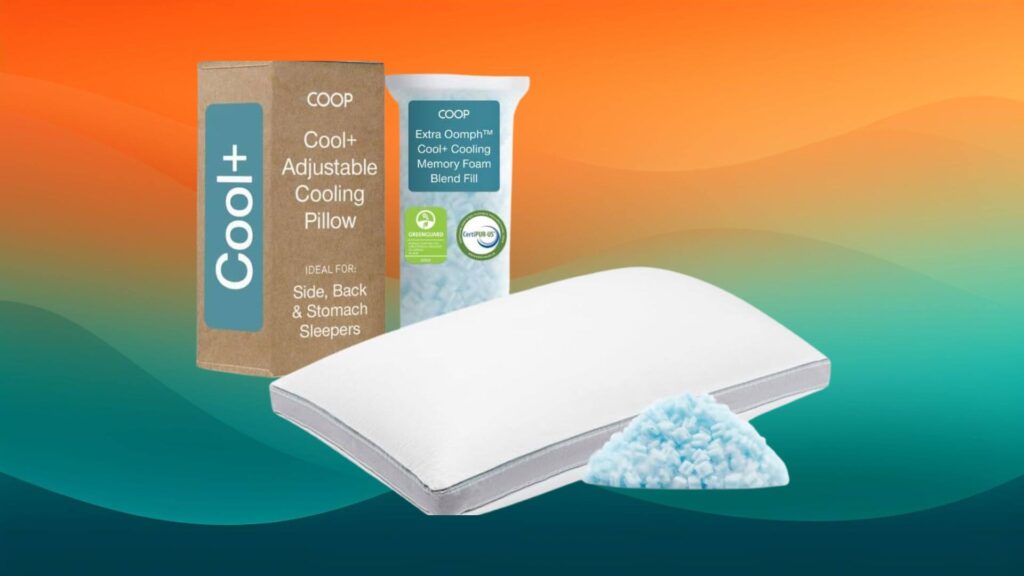
We are reader-supported. When you buy through links on our site, we may earn an affiliate commission.
Have you ever wanted to pack away this season’s baggy coats and jackets because they take up so much closet space? A vacuum storage bag can make your life much more organized and convenient when seasonal clothes take over. If you’ve ever struggled to squeeze in more storage, vacuum seal bags could be your answer. These airtight compression storage solutions shrink your clothes to a fraction of the size, making organizing easier than ever.
What Is a Vacuum Storage Bag and Why Use One?
A vacuum storage bag is a specially designed plastic bag that removes excess air to compress clothing, bedding and other soft items. It works by using a vacuum or hand pump to extract air, significantly reducing the overall volume of your stored items.
Initially designed to serve in the food industry to keep food fresher for longer, these bags are now repurposed to store and organize clothes, wrap machine parts, and protect upholstery during transport. Vacuum applications are endless.
Benefits of Vacuum Storage Bags
Vacuum seal bags are a fantastic investment. Choose a vacuum seal bag to:
- Maximize space: Clothes shrink to a quarter of their size, freeing valuable storage space.
- Protects against dust, mold, moisture, and pests: The airtight seal keeps your clothes fresh and clean and prevents bugs and mold spores from gaining access.
- Perfect for seasonal storage: Keep your out-of-season clothes neatly packed and organized while also minimizing wrinkling.
- Easy to stack and organize: Label bags and pack them neatly in storage spaces like shelves and under the bed.
- Great for travel: Pack more in your suitcases without exceeding the weight limits. A fantastic space-saving way to transport your whole wardrobe and bedding without taking up excess space when moving home.
How to Use a Vacuum Storage Bag Correctly
To use a vacuum seal bag effectively requires a little preparation, but the steps are easy. To ensure the best results, you should:
- Sort and prepare clothes or linens: Wash and dry items before storing to prevent trapping moisture or odors. Wet clothes will mold in sealed bags.
- Fold clothes neatly: Folding your clothes helps prevent uneven compression and stops dents from forming. Plus, you can also pack more in a bag than when bundling clothes in the bag.
- Pack efficiently: Avoid overfilling the bags — leave some space near the seal to create an airtight result.
- Seal the bag properly: Ensure the zipper closure is correctly sealed to create an airtight seal.
- Remove the air: Use a vacuum cleaner or hand pump to suck air from the bag until it flattens.
- Store in a cool, dry place: Label your bags and keep them in a secure location away from sunlight, heat, excess cold or sharp objects. Avoid basements where damp can damage the seal and contents.
Bag Sizes
You should choose a vacuum seal bag in the size that works best for the items you’re storing. The size depends on what goes inside the bag. Your options include:
- Small (16×24 inches): Ideal for T-shirts, baby clothes and small accessories like soft toys.
- Medium (18x 28 inches): Works well for sweaters, jackets and bedding like pillowcases and flat sheets.
- Large (22×32 inches): Fits bulkier clothes like coats and sweaters or smaller blankets.
- Extra-large (30×40 inches): Best for heavy-duty storage like duvets, blankets and winter gear.
Some brands offer jumbo sizes and specialized vacuum seal bags like coat bags, which offer extra length and space for coat hangers.
What Can You Store?
While it’s easy to believe you can store anything in a vacuum seal bag, it’s mostly for safely securing these items:
- Clothing: Seasonal wear, formal attire and kids’ clothes.
- Bedding: Blankets, comforters, pillows and mattress toppers.
- Towels and linens: Beach towels, guest bedding and extra sheets.
- Stuffed animals and soft toys: Fantastic way to store childhood keepsakes.
- Camping and travel gear: Sleeping bags and bulky outerwear.
Some items aren’t meant for storage in vacuum bags. These items are primarily solid, meaning vacuuming won’t reduce their size or they are too rigid and can damage the vacuum bag. Avoid sealing things like shoes, kitchen utensils and other containers.
How to Seal a Vacuum Bag
Sealing a vacuum bag properly ensures long-term storage without losing compression. Follow these steps for an effective seal:
- Close the zipper tightly: Run your fingers along the seal multiple times to ensure it’s fully shut and locked in place.
- Attach the vacuum or pump: Place the vacuum nozzle over the air valve and turn it on. If using a hand pump, attach it and start pumping.
- Watch the bag compress: Stop once the bag reaches maximum compression, ensuring the clothes don’t become overly crushed or get sucked into the valve.
- Secure the valve: Some bags have a screw-on cap, while others automatically seal because of a one-way valve. Double-check that no air is escaping.
Top 5 Vacuum Seal Bags for Clothes With Pump
1. Gongshi 15 Pack Vacuum Storage Bags With Electric Pump
This mixed pack of vacuum bags is perfect for organizing a spare closet at home. Each bag can reduce the contents size by as much as 80% under compression. The set includes three jumbo, three large, three medium, three small bags and three roll-up bags. It’s enough to neatly compress and store a fully packed closet of winter clothes and comforters. The double zip ensures maximum airtight closure, and the handy electric pump is ideal for compression.
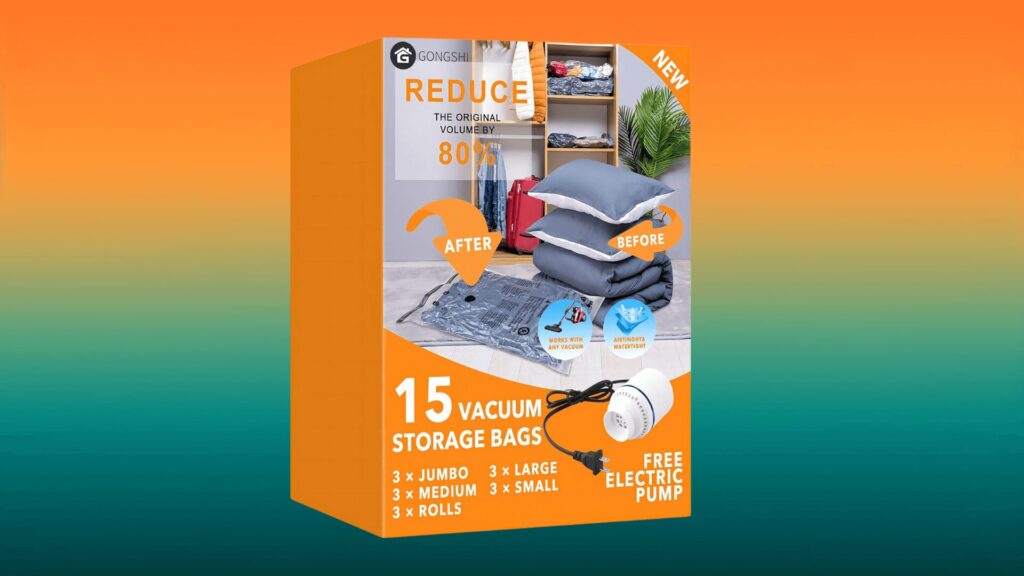
2. Cosy Essential 20-Pack Vacuum Storage Bags
This bulk pack contains 4 jumbo, extra-large, large, medium, small and roll-up bags. The design offers extra protection with a triple valve and a double-seal zipper, but it comes with a manual pump only, so it’s going to take a little elbow grease to compress all the bags.
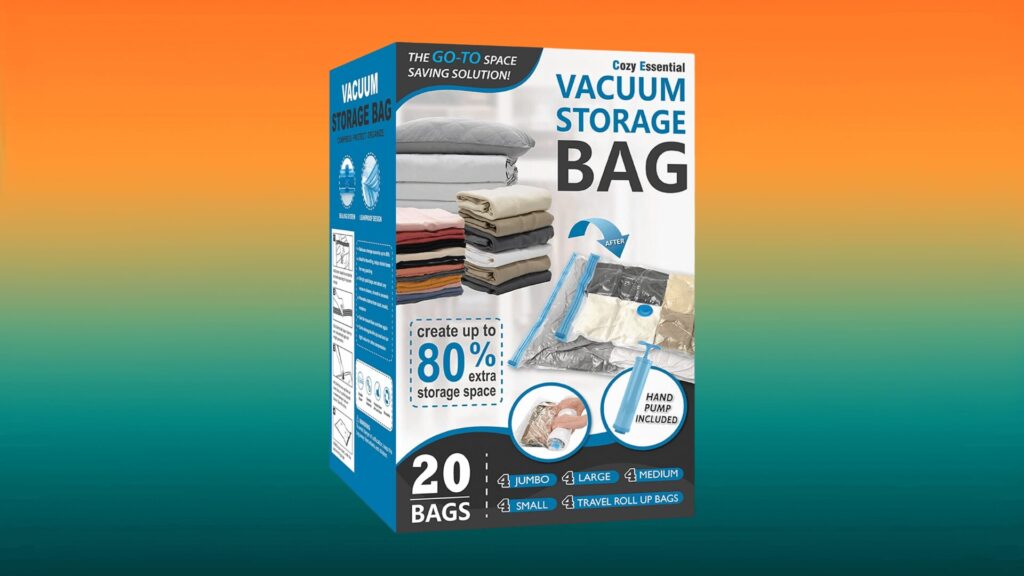
3. Hibag Vacuum Storage Bags With Electric Pump
If you’d prefer to get several bags of the same size, these bags are ideal. Choose from bulk bags in a mixed variety or several large bags up to jumbo size. These 10 jumbo bags are perfect for repacking and storing your winter bedding and extra pillows. The set comes with a USB-powered electric pump so you simply pack a bag and compress it in 30 seconds with the push of a button. Maintain compression with the double zipper and a leak-proof valve.
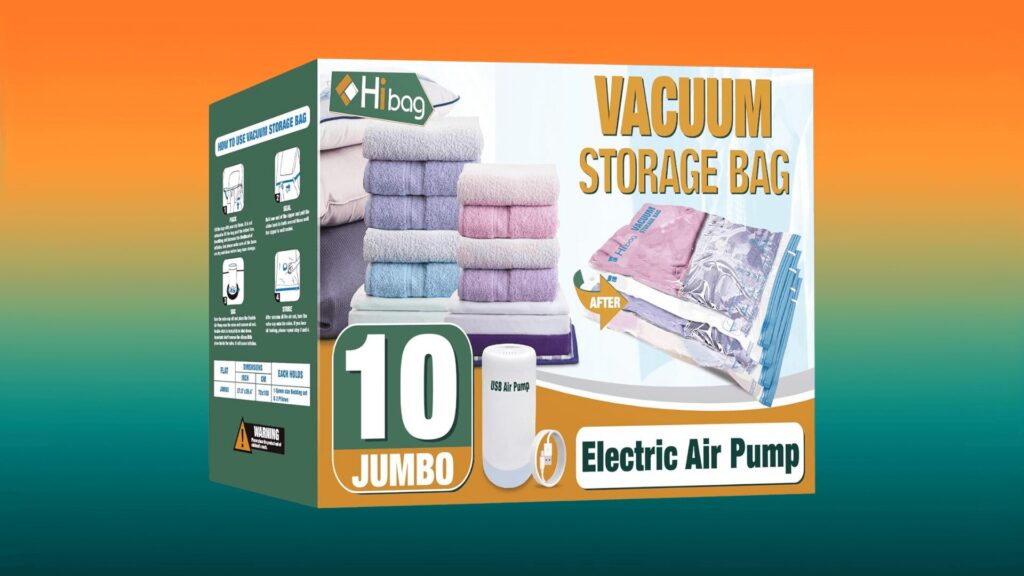
4. ACFOT Space Saver Bags
For private and convenient storage, these patterned bags are ideal for organizing your closet without having the compressed items on view. It’s a neat and universal way to create order in your closet. Remember to label the bags with a marker so you know what’s in the bags. The set includes two small, four large, four medium and two jumbo bags with a manual pump.

5. Storage Logic Foam Mattress Vacuum Bag
One of the largest items to keep in storage is a foam or bed-in-a-box type mattress. Keeping them under compression makes much more sense and frees up an amazing amount of space. This compression bag works with a vacuum cleaner, and it includes binding straps, so you can reduce the mattress size by 80% and then roll and strap it for easy storage.
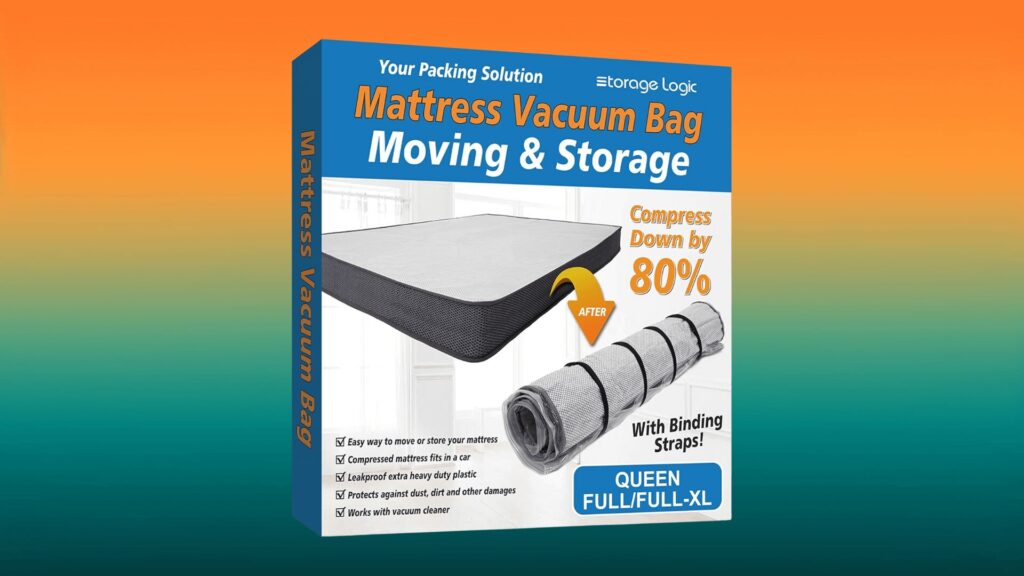
How to Choose Vacuum Seal Bags
Not all vacuum bags are created equal. To get the best ones for your needs, consider these factors:
- Material quality: Look for thick, durable plastic that won’t tear easily.
- Seal strength: A double-zip seal offers better protection against air leaks.
- Type of vacuuming method: Some bags require a vacuum, while others come with a hand pump. Manual bags usually require that you force the air from all sides toward the seal before closing them, offering a basic compression. While manual bags are great for situations with no electricity, they don’t provide full compression.
- Size variety: A multi-size pack offers flexibility for different storage needs.
- Reusable design: High-quality bags can be used multiple times without losing their seal.
FAQ
How Long Can You Store Clothes in Vacuum Bags?
Clothes can stay compressed in vacuum bags for several months up to a year, depending on the fabric type. However, storing delicate or natural fibers like wool, silk or down feathers for long periods can cause fiber compression, making them lose shape. For long-term storage, it is best to remove clothes and let them air out every few months.
How to Store Vacuum Storage Bags?
For best results, store vacuum bags in a cool, dry place, away from direct sunlight and sharp objects. Under-the-bed storage, closet shelves or storage bins work well. Avoid placing them in humid environments like basements or attics, where moisture buildup could compromise the seal or the contents.
Store unused vacuum bags flat, ensuring no pressure on the seams or the seal. Avoid folding them, as this can cause the plastic to crack.
What Size Vacuum Storage Bag Should I Buy?
It depends on what you are storing. Use small or medium-sized bags for clothing and travel. Large or extra-large bags work best for bedding, winter coats and bulky items. Jumbo-sized bags are perfect for storing or moving large textile items like duvets.
Vacuum Seal It
Vacuum storage bags are a game-changer when it comes to organizing your space, protecting your belongings and making the most of your storage areas. Whether you need a storage solution for seasonal clothes, travel or long-term storage, these simple yet effective bags can help you declutter effortlessly.







